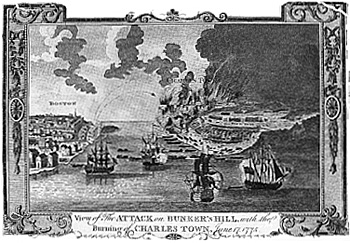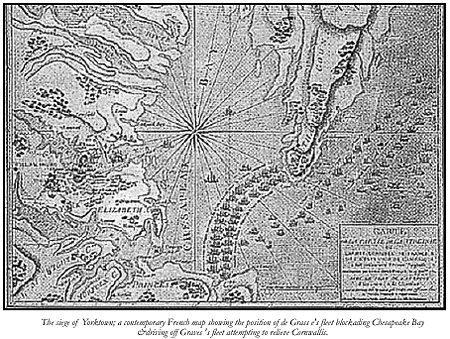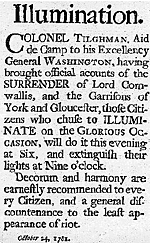
It is now over two hundred and twenty years since the
American Revolution began and arguments still rage over its
origins. There is always the popular arguments that are based
on the ideas that revolution was fuelled by the desire to shake
off the chains of foreign rule by a tyrannical monarch. On
the other side there arguments put forward by some
academics that the revolutionaries were self interested
hypocrites mouthing clichés about democracy and freedom
to the masses in an effort to protect their own individual property rights. 1
Whatever the reasons, popular or otherwise, the period between the skirmish at Lexington and
the siege of York was one of revolutionary change in the
history of warfare. Revolutionary because it is not only one
the first examples of global warfare but also because it is a
war fought between a major colonial power and colonists of
European decent. It is also revolutionary as the first example
of a major revolutionary war where the ideal of “nation - in - arms’ plays a crucial role . 2
The year of 1775 saw civil disturbances in Britain’s American
colonies escalate into open warfare. The blame for this turn
of events is often laid at the feet of General Thomas Gage
who eagerly sought permission to suppress the activities of
American troublemakers with a show of military force.
However, when Gage finally received the orders he desired
he put them into effect so ineffectively that after defeats at
Concord, Lexington and Bunker Hill, he was replaced. For
both sides the Battle of Bunker Hill was, at best a tactical
draw but it signaled the end of the political phase of the
revolution and represents the beginning of a war for independence . 3
The standout decision of 1775 occurred at the Second
Continental Congress. The decision was to elect General
George Washington as Commander in Chief of the army.
Appointing Washington is seen as a surprise move
considering that until the time of his election his military
career had been continually frustrated. His involvement in
actions at Fort Duquesne and Braddock’s ill fated
Monongahela expedition, during the French and Indian War,
did not inspire thoughts of a great military career. Furthermore, his efforts to distinguish himself from the
regular crop of provincial officers of the Crown had also met with failure . 4
Nevertheless, what Washington did posses
was patience, perseverance and courage, attributes that made
him a great strategist and enabled him to keep his army
together when hardship and defeat threatened to destroy it.
Field Marshal Montgomery, of World War II fame, commented that Washington, matured as a leader
throughout the course of the war but was never more than a mediocre soldier . 5 This comment may seem harsh when considering Washington’s overall talents as a commander,
however if taken as a reflection of his tactical abilities in
combination with his lack of success on the battlefield, then
the comment is well-founded.
Although the American colonies declared their independence on the 4th July 1776, the British increased their
efforts to subdue the rebels. The war was not popular in
Britain, neither were there sufficient British troops to supply
the needs of commanders in America. To meet the military
needs of the generals the government in London introduced
troops hired from various German states after failing to
secure the support of Catherine the Great of Russia . Quite
incorrectly these troops are often referred to as mercenaries,
incorrectly because they were never hired on an individual
basis, but were regular army troops in the employment of
their home states.
Their introduction did give British commander, Sir William Howe, the extra muscle he required.
Howe, initially gained victories at Long Island, White Plains,
Fort Washington and Fort Lee. Even though Howe
achieved these victories he is generally considered to be a
cautious commander and it has been determined that the
task he faced, of imposing a plan of united and coordinated
action, in north America was never going to be achieved. 6
When the nature of the geography of the American continent and continued political interference from London are also taken into account then the reasoning is certainly strong.
During this period Washington used his extraordinary
powers of perseverance and patience to great effect, just to
keep his army together. His patience was rewarded and
American morale boosted when at Trenton he crossed the
Delaware and surprised then defeated the German force
stationed there. A further boost to American morale came
with another victory in early January 1777, this time against
the British at Princeton. Shocked by these twin defeats Howe
ordered that his outposts be drawn closer to New York. This
decision left Washington and his army free in New Jersey,
therefore saving the army from disintegration.
Howe’s next step was to attempt the capture of Philadelphia.
Washington made an attempt to stop him along the line of
Brandywine Creek, he failed, mainly due to poor
reconnaissance work and Cornwallis’ flank march. Howe’s
force eventually marched into the American provisional
capital. The battle at Germantown was Washington’s attempt
to dislodge the British from Philadelphia through a surprise
attack, this failed also, leaving the British to settle down in
their comfortable winter quarters while Washington and his
army went into less comfortable quarters at Valley Forge.
Meanwhile in the north General John Burgoyne with a mixed
force of British, German, Loyalist and Native Americans
advanced southward from Canada. The aim of the campaign
was to link up with Howe and his army advancing along the
Hudson River to Albany. The effect of such a union would
have meant the closure of the Hudson River to the
Americans and created a physical split between the rebellious
northern colonies and the colonies of the south, which the
British believed to be loyal.
As seen, Howe had other ideas and Burgoyne was left on his own. Trying to apportion blame for the failure of the British army in the Saratoga
campaign is not important, out numbered and with no
chance of resupply Burgoyne had little choice but to
surrender. The importance of the defeat was that it
convinced the French to openly join the war against Britain.
What had been a struggle to maintain control over their
thirteen colonies in America had, for the British, developed
into global conflict that by 1780 also included Spain and the
Netherlands.
1778
Militarily 1778 was a quieter year, Washington remained in
command of the American army and Sir Henry Clinton had
succeeded Howe who had resigned as commander of the
British and their allies. Clinton was unique amoung the
senior British commanders of the war. Born in
Newfoundland he was the only one with a natural connection with North America. 7 The year however, marked
significant changes in the direction of the war. Firstly, the
battle at Monmouth virtually ended the war in the northern
theatre with the seat of the war moving south, a region
which the British saw as a Royalist stronghold.
Second, 1778 also saw the first active involvement of French forces. The
inauspicious start with the action at Newport resulted in
anti-French riots in many cities, the worst being in Boston.
Comte D’Estaing, the French commander, cannot be held
singularly responsible for the failure, his unwillingness to
commit his fleet in unfamiliar waters, without reliable charts
or local pilots and with the possibility of imminent storms is
an understandable response for a sailor.
1779
1779 saw American victories at Kettle Creek, Stony Point
and Paulus Hook. The year also saw increased French
involvement in the war. The siege of Savannah was another
chance for D’Estaing to prove to the Americans the value of
a Franco-American alliance. However, the siege ended in
failure with D’Estaing forced, by approaching storms at sea
to assault the town earlier than originally planed, the assault
failed and the siege called off. D’Estaing was again criticised
for his role in an operation, perhaps unjustly.
Historians, while being quick to criticise, fail to recognise that in the lead
up to the siege of Savannah D’Estaing and 1500 of his men
were stranded for six days with no shelter or supplies in
hostile territory. This feat is made remarkable by the fact that
they remained completely undetected. If British or Loyalist
units had detected this force the possibility of producing a
morale boosting victory over French regulars may have led to
the French re-thinking their involvement in the war.
1780
May of 1780 saw what is argued as the Americans greatest defeat of the war .8 General
Benjamin Lincoln surrendered the city of
Charleston, South Carolina, to the British.
Quite unfairly Lincoln is made a scapegoat
even though he is significantly outnumbered
and like Cornwallis at Yorktown he had no
chance of relief. The surrender gave Britain a
second major port city in the south. Alarmed
by British success in the south Washington sent
General Horatio Gates, the ‘victor’ of
Saratoga, to command the American southern
army against British general, Charles
Cornwallis.
Gates however, blundered to an
embarrassing defeat at Camden and was
replaced by General Nathaniel Greene. The
outlook for the Americans looked grim, the
outlook worsened when Benedict Arnold, the
disgruntled hero of Saratoga, went over to the
British cause, it was an act which, in the end,
achieved nothing. A victory over a British force
e being arguably the most talented and formidable of the
at Kings Mountain gave American morale a critical boost.
Problems for the British increased as Cornwallis, despite
being arguably the most talented and formidable of the
British field commanders, failed to understand the nature of
the southern topography nor the fighting qualities and
tactics of the patriots . 9
Now with Nathaniel Greene, the only American general to
serve with Washington for the entire war, in command of the
army in the south and with the exceptional Daniel Morgan
leading in the field the Americans won a crushing victory
over Banastre Tarleton at Cowpens. In the words of Morgan they gave Tarleton “a devil of a whipping”.
10 Cornwallis,
perhaps eager to redress the balance after Tarleton’s defeat
met Greene at Guilford Court House.
Greene adopted a defensive posture and Cornwallis, in line with his aggressive
nature, attacked. Although, the battle was a tactical victory for the British Cornwallis’s casualties were so great and his
cavalry arm so small that he was unable to make the victory decisive.
Greene’s command of the American army in the south
makes an interesting study. Although he failed to win a
victory in the field, his subordinate commanders, Morgan,
Henry Lee and Francis Marron utilised harassing tactics that
eventually forced the British into there strongholds of
Charleston and Savannah where they remained ineffective.
At this point it is interesting to note that the harassing tactics
employed by Greene and his subordinates were more in line
with the theories expounded by Charles Lee earlier in the
war. Lee’s theories centred on the use of local militia forces,
skirmishing and harassing the enemy to wear them down.
Washington had previously spurned Lee’s theories
preferring to adopt European style linear tactics using
regular troops.
There are significant differences between the
terrain over which Washington fought his battles and the
rivers and swamp systems of the south where Greene
commanded. This is put forward as the major reason for the
commanders adopting different tactical styles. Despite the
differences in style, it is also argued that Greene’s tactics
played a much greater role in forcing the surrender of
Cornwallis at Yorktown than the formal European tactical
doctrines used by Rochambeau and Washington during the siege . 11
Yorktown
Sir Henry Clinton, British Commander in Chief, suggested to the frustrated Cornwallis two options. First, advance by land and link up at New York, or second take up a defensive position on the coast to be transported by sea. Without clear orders from his superior Cornwallis retired, by land, to Yorktown, Virginia. Even as he retired with Lafayette’s American troops nipping at his heels, Cornwallis still had enough of his fighting spirit to ambush Lafayette's advancing columns at Jamestown Ford, only night saving the impetuous French aristocrat.
Finally arriving at Yorktown, Cornwallis survived three weeks of siege before surrendering. The surrender occurring only after the
Royal Navy had failed to break the French blockade and storms had prevented evacuation by small boat to Gloucester on the other side of
Chesapeake Bay. Such was the magnitude of the surrender at Yorktown that effective British military involvement in North America ceased.
Tactically the war did not introduce any new or radically different military theories. However, it reintroduced many of the theories of light infantry tactics that had been developed during the French and Indian Wars by officers such as Wolfe, Howe and Amherst. These tactical doctrine had fallen into disuse and the British army had re-‘Prussianised’ itself. It took a renewal of conflict in America for the British to
relearn the role of light infantry . Certainly the idea of the British fighting in a European style with the Americans fighting a guerrilla war is something of a fallacy. 12
Even though the Americans were more flexible in their approach, the armies commanded by Washington fought in a linear style that their British opponents would have been quite used to. The failure of the Americans in set piece battles gives weight to the argument that they could not compete with the high standards of training and discipline of the British regulars.
The case that the British evolved and developed tactics suitable to the north American battlefield has often been ignored, instead the failures of York, Bunker Hill and the Saratoga campaign are shown as typical examples of the British method of fighting. Campbell’s capture of Savannah, the attack on the American rear by Prevost at Briar Creek and the flank march by Cornwallis at Brandywine are evidence of the flexible and mobile capabilities that the British army possessed. 13
The great rivers, forests and lakes presented much greater difficulties to the British than the nature of the topography in Europe. 14 Particularly
when the armies were attempting to subdue a large continent while drawing their supplies from coastal ports. Guibert argues that this factor alone was the great equaliser in the conflict. 15 Many of the arguments presented, may appear to be pro-British, in some cases this is intentional since much of the
popular image of the war relates to American brilliance and British stupidity. Certainly, there are examples of both these extremes, Cowpens and Bunker Hill being two respective samples. However, applying this combination to the entire war gives an unbalanced and unhistorical viewpoint. More often than not British competence and American ineptness was the combination. In the end what remained was a new but distinctly unstable nation.
A nation that again fought the British in 1812 and turned in on itself with a Civil War in the 1860’s where the paths left bloody by the armies of Greene, Cornwallis and Washington were again bloodied by their descendants Lee, Longstreet, Grant and Meade.
1 Morgan, E. S. Revisionists in Need of Revising in Billias, G. A. (ed). The American Revolution; How Revolutionary Was It?, p40 - 41.
 The siege of Yorktown; a contemporary French map showing the position of de Grass e's fleet blockading Chesapeake Bay & driving off Graves 's fleet attempting to relieve Cornwallis.
The siege of Yorktown; a contemporary French map showing the position of de Grass e's fleet blockading Chesapeake Bay & driving off Graves 's fleet attempting to relieve Cornwallis.
 In essence the failure of the British to succeed in defeating the patriots, is in part based on the strategic rather than the tactical errors of commanding generals, political interference from London and the lack of cohesion and communication between commands. However historians argue that the main reason for British defeat lies in the nature of the country.
In essence the failure of the British to succeed in defeating the patriots, is in part based on the strategic rather than the tactical errors of commanding generals, political interference from London and the lack of cohesion and communication between commands. However historians argue that the main reason for British defeat lies in the nature of the country.
Footnotes
2 Black, J. European Warfare 1660-1815 , pp158 - 159.
3 Marsh, W. Bunker Hill, A Dear Bought Victory , p 12.
4 Keegan, J. Warpaths , p 167.
5 Montgomery, B. L. A History of Warfare , p 321.
6 Keegan, J & Wheatcroft, A. Who's Who in Militar y History , p 164.
7 Keegan, J & Wheatcroft, A op cit , p 74.
8 Commanger, H & Morris, R. The Spirit of Seventy Six , p 1073.
9 Alden, J. R. The South in the Revolution , p 247.
10 Morgan, D. in Alden, J. R. op cit , p 254.
11 Strachan, H. European Armies and the Conduct of War , p 29 - 30.
12 Ibid.
13 Black, J. A Military Revolution? , in Rogers, C. J. (ed). The Military Revolution Debate, p 109.
14 Quimby, J. Background to Napoleonic Warfare , p 264
15 Guibert in Quimby, J. op cit , p 265.
Back to Table of Contents -- Kriegspieler #9
To Kriegspieler List of Issues
To MagWeb Master Magazine List
© Copyright 2000 by Kriegspieler Publications.
This article appears in MagWeb (Magazine Web) on the Internet World Wide Web.
Other military history articles and gaming articles are available at http://www.magweb.com